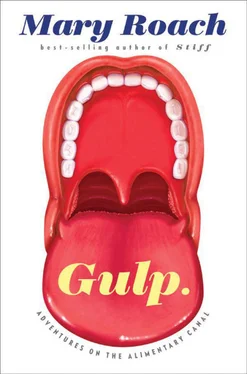Not so fast, says rival American Journal of Emergency Medicine. The article title says it all: “Low Risk of Infection in Selected Human Bites Treated without Antibiotics.” Only one out of the sixty-two human-bit patients who were not given antibiotics developed an infection. However, the authors excluded high-risk bites, including “fight bites” on the hands. Here it is the aggressor who gets the “bite”—when he splits open his knuckle on another man’s teeth. Fight bites [47] Fear the fight bite: it can cause septic arthritis. In one study, 18 of 100 cases ended in amputation of a finger. Hopefully the middle one. In the aggressive patient, a missing middle finger may be good preventive medicine.
tend to get infected, but it is the fault of the knuckle as much as the saliva. Relatively little blood flow reaches the tendons and sheaths of the finger joints, so the immune system has fewer resources with which to fight back. (Ear cartilage is similarly underserved by the vascular system, so if you plan on picking a fight with Mike Tyson, do practice good wound toilet.)
Even the “deathly drool” of the Komodo dragon, the world’s largest lizard, has likely been overstated. Theory holds that Komodo dragon saliva contains lethal doses of infectious bacteria, enabling the reptiles to take on prey far larger than themselves—wild boar, deer, newspaper editors. ( San Francisco Chronicle ’s Phil Bronstein spent several days on an antibiotic drip after a Komodo dragon attacked his foot during a behind-the-scenes visit at the Los Angeles Zoo in 2001 with his then wife, Sharon Stone.) Rather than having to tackle and kill their prey on the spot, the theory goes, the reptiles need only deliver a single bite and then wait around for the animal to die of sepsis. The scenario has not been documented in the wild, however. A team of researchers from the University of Texas at Arlington attempted a laboratory simulation, using mice as mock prey and, as predator, injections of bacteria from wild Komodo dragon saliva. The scientists found a high death rate among mice injected with a particular bacteria, Pasteurella multocida . However, Australian researchers point out that P. multocida is common in weakened or stressed mammals. They speculate that the dragons may have picked it up from their prey, rather than the other way around. Current thinking postulates a “sophisticated combined-arsenal killing apparatus,” featuring venom and anticoagulative agents that lead to shock. The latter would explain “the unusual quietness… of prey items.” Prey item Phil Bronstein was unusually not quiet. [48] The zookeepers, however, got very, very quiet. “So maybe,” said Bronstein in an e-mail, “the dragon spit some of its quietness spray on them.” I am almost 100 percent sure that that is not a reference to Sharon Stone.
“I was pretty pissed.”
Though bacteria and general ropy grossness are probably to blame for saliva’s nasty reputation, it may in part be lingering fallout from the writings of Hippocrates and Galen, Western medicine’s most influential early (as in, triple-digit A.D. and B.C.) thinkers. Both believed sweat and saliva to be the body’s way of flushing away disease-causing impurities. Before scientists realized syphilis and malaria were caused by microorganisms, the diseases were treated by putting patients in “salivating rooms.” It was the same medically quaint principle that persists today in the form of taking a steam or a sauna to “sweat out toxins.” Only back then, the steam included vaporized mercury [49] The term quack derives from quacksalber , German for “quicksilver” (mercury’s nickname). It took a while for medicine to see the light. As late as 1899, the Merck Manual suggests mercury as an antisyphilitic, to “produce salivation.” Syphilitics weren’t the only ones salivating over mercury. Merck was, at the time, reaping profits from eighteen different “medicinal” mercuries.
to coax more saliva from the patient. No one realized that excessive salivation is a symptom of acute mercury poisoning. The salivating room was a standard feature of hospitals in the 1700s. (As was, charmingly, the “apartment for lunatics.”) Patients were left inside until they’d generated six pints of saliva—about three times the amount most people produce in a day.
Not all cultures denigrate saliva. In ancient Taoist medical teachings, stimulated saliva—“the jade juice”—was said to nourish the qi, which boosts the immune defenses and, wrote one seventh-century Taoist, “puts a man beyond the reach of calamities.” Given this tradition of qi-nourishing saliva retention, why do I so often see old Chinese men spitting? Silletti points out that it’s not saliva being expectorated. It’s phlegm from the lungs or sinuses. They spit it out, she added, because they don’t care to use handkerchiefs or Kleenex. They think it’s disgusting that we collect the material in our hands.
For saliva-positive attitudes, there is no place like Greece. “Greeks spit on pretty much anything they want to protect from the evil eye or bless for good luck,” says Evi Numen. Numen is the exhibitions manager at the Mütter Museum, [50] Not to be confused with the Nutter D. Marvel Museum of horsedrawn carriages or the Butter Museum, a working farm that “showcases all things butter, from various styles of butter dishes to the history of butter through the ages,” perhaps turning away briefly during butter’s history-making 1972 role in Last Tango in Paris .
a collection of medical curiosities amassed by Thomas Mütter and housed today at the College of Physicians of Philadelphia. Though her job qualifies her to comment on most things bodily and disgusting, her salivary expertise derives from her upbringing. Numen is of Greek extraction. Greeks spit on babies. They spit on brides. They spit on themselves. Though no actual gob is launched. “Most people,” explains Numen, “say ‘ ftou ftou ftou ’ instead of actually spitting.”
The Greeks got it from the Roman Catholics, whose priests used to baptize with spittle. The priests got it from the Gospel of Mark—the bit where Jesus heals the blind by mixing dirt with his saliva and rubbing the mud on a man’s eyelids. “It’s an interesting passage,” former Catholic priest Tom Rastrelli told me, “because the writers of the gospels of Luke and Matthew, who used Mark as their source, redacted a line.” Mark had included a bit about a blind man opening his eyes and seeing what looked like trees walking around. In other words, the treatment was minimally effective. The miracle of Jesus bestowing rudimentary vision to the blind doesn’t have the same ring to it, so the line was cut.
THE DUTCH, BY tradition, are a dairy-farming people. Adults drink milk with dinner. A town will have a shop devoted entirely to cheese. The national dish of the Netherlands, sighs Silletti, is vla : custard. I have been staying in the home of food scientist René de Wijk, the world’s foremost expert on the science of semisolids like vla . Upon hearing this, Silletti immediately, as though it were a matter of medical urgency, invited me over for home-cooked Italian food.
Silletti is lactose-intolerant and, as concerns Dutch cuisine, just generally intolerant. “Everything is based on milk,” she says, arranging sundried tomatoes for a plate of antipasto.
Silletti’s home is a twenty-minute drive from Germany, where the supermarkets sell a decent range of Italian products. She regularly travels across the border to stock up. I don’t blame her. The supermarket near de Wijk’s house sells things like gorte pap—buttermilk barley porridge—and Smeer’m, a kind of spreadable cheese vileness. I’d go home with a cucumber and some peanuts because I wanted something real, something with crunch, something that didn’t sound like a gynecology exam. There was an entire aisle devoted to vla.
Читать дальше












